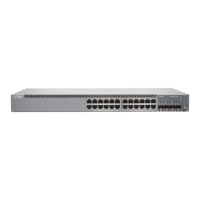CHAPTER 15
Performing Initial Configuration
•
EX2300 Switch Default Configuration on page 173
•
Connecting and Configuring an EX Series Switch (CLI Procedure) on page 179
•
Connecting and Configuring an EX Series Switch (J-Web Procedure) on page 182
•
Reverting to the Default Factory Configuration for the EX Series Switch on page 186
EX2300 Switch Default Configuration
Each EX Series switch is programmed with a factory-default configuration that contains
the values set for each configuration parameter when a switch is shipped. The default
configuration file for an EX2300 switch configures Ethernet switching and storm control
on all interfaces, configures Power over Ethernet (PoE) on all interfaces of models that
provide PoE, and enables the LLDP, LLDP-MED, and RSTP protocols and IGMP snooping.
When you commit changes to the configuration, a new configuration file is created that
becomes the active configuration. You can always revert to the factory-default
configuration—EX2300 switches do not have LCD panel, use the CLI commands to revert
to the factory-default configuration. See “Reverting to the Default Factory Configuration
for the EX Series Switch” on page 186.
The following factory-default configuration file is for an EX2300 switch with 24 ports
with PoE capability.
NOTE: The factory-defaultconfigurationfile is different for differentEX2300
switch models.
The number of interfaces in the default configuration file depends on the
number of ports in the EX2300 switch.
The poe statement does not appear for models without PoE.
Uplink ports on EX2300 switches except EX2300-C switches are listed as
ge-0/1/0 to ge-0/1/3 and xe-0/1/0 to xe-0/1/3. Uplink ports on EX2300-C
switches as ge-0/1/0 to ge-0/1/1 and xe-0/1/0 to xe-0/1/1.
system {
auto-snapshot;
173Copyright © 2017, Juniper Networks, Inc.

